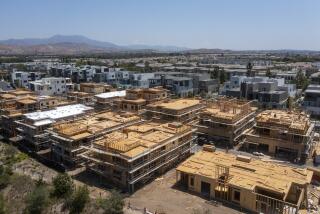Aging Population Setting Up New Homes at Fast Pace : Average Household Size Drops to Record Low of 2.67
WASHINGTON — The number of people in the average American household has dropped to its lowest level ever, as the nation’s maturing population is setting up new homes faster than the overall population is growing.
The typical household included only 2.67 people as of last July 1, a number that has been declining steadily over the years, the Census Bureau reported Tuesday. The average was 2.76 in 1980.
The major reason for the decline is the fact that America is aging--the share of adults in the population is growing in contrast to younger people, Campbell Gibson of the Census Bureau said.
The number of people per household fell as household growth outstripped the population increase by 10.5% to 6.4% between 1980 and 1986, the agency reported.
Households increased to 88.8 million from 80.4 million, and the total population grew to 241 million from 226.5 million. The average household size is calculated using a smaller population figure, because several million people live in college dormitories, prisons, hospitals and other institutions that are not counted as households.
The presence of children in a population tends to increase household size, Gibson noted, while a larger share of adults is more likely to result in people going off on their own and setting up smaller, independent households. That has been a major factor in the last decade or two, he said.
For example, Gibson said, in 1964 the typical household included 3.33 people, of which 1.23 were under the age of 18 and 2.10 were adults. By last year, the average of 2.67 people included 0.71 under 18 and 1.96 adults.
About three-fourths of the decline in household size is in the under-18 age group.
Changes in living arrangements of adults have been a secondary factor, Gibson added. For example, the increasing divorce rate in the 1960s and 1970s caused household size to shrink as more adults found themselves living alone.
A household is an occupied living unit and can comprise one or more people. Households are, on average, smaller than families because the definition of a family requires a minimum of two people. The new report looked only at households.
The decline in household size has been under way since the last century. The average American household contained 5.04 people in 1880, slipping to 4.93 in the 1890 Census and to 4.76 at the start of this century.
Among the states, only California deviated from the national pattern of household growth’s outstripping growth of the general population. In California, the total population and the number of households both increased by 14% between 1980 and 1986.
The reason is a major shift in the ethnic mix in California, Gibson said.
In this decade, Asians and Latinos have increased to 25% of the California population from 15%, he said, and the fact that those groups tend to form larger households is having a major impact on that state.
Asian families in general are more likely to form extended households, with the elderly living with their children and grandchildren, Gibson said.
And Latinos in California also tend to have more adults per household, a situation that does not seem to hold true nationally, Gibson said.
More to Read
Sign up for Essential California
The most important California stories and recommendations in your inbox every morning.
You may occasionally receive promotional content from the Los Angeles Times.










